Which of Today’s Four Featured Images is the Strongest Overall?
Please leave a comment and let us know why you made your choice. My favorite will likely surprise most folks.
Wanted to Buy
On the off chance that someone has a Sony 200-600mm G lens sitting on a shelf that they would like to get rid of for a decent price, please contact me via e-mail; I have a serious prospective buyer.
What’s Up?
Thanks to the ridiculous weather forecast, I enjoyed a full day of rest and catching up (mostly catching up) without making a single image.It was my first day off since 2 August. The rain all day with thunderstorms forecast was a bit off. It did not rain a single drop after 5am. By midday it was mostly sunny and the sun remained out until it clouded over at 6pm. The revised midday forecast had called for cloudy skies with rain and thunderstorms.
Today is Tuesday 23 August. The forecast for the morning is for cloudy with a SW wind. I woke early but decided to stay in again. Wherever you are, and whatever you are doing, I hope that you too have a great day. This blog post took about two hours to prepare (including the time spent on the four new image optimizations) and makes one hundred fifty-one days in a row with a new one.
Please remember to use the B&H and Amazon links that are found on most blog pages and to use the BIRDSASART discount code at checkout when purchasing your new gear from Bedfords to get 3% back on your credit card and enjoy free second-day air FedEx. Please, also, consider joining a BAA IPT. You will be amazed at how much you will learn!
Time is Running Out
Many folks are scheduled to join me at either Nickerson or JBWR in the next two weeks for an In-the-Field session or two. The first window for doing shorebirds at the East Pond at Jamaica Bay Wildlife Refuge has closed. The second window is from 24-26 August. I have a private client on the 26th. See the additional details below. Muhammad Arif enjoyed three In-the-Field sessions and made lots of great images with his R5. I hope to share some of them with you here soon. Carlotta Grenier came for her third session recently and Sanjeev Nagrath learned a ton during his three Nickerson Beach sessions. Sandy Brown will be flying in from Seattle for an afternoon at Nickerson and a morning at JBWR this coming week. I head south to catch the Auto train on 31 August.
|
|
|
Clockwise from the upper left corner back around to the center: Wilson’s Phalarope, JBWR; just fledged Common Tern, Nickerson; Black Skimmer, adult skimming, Nickerson; Black Skimmer killing tiny skimmer chick, Nickerson; American Oystercatcher foraging at sunrise, Nickerson; Common Tern chick swallowing baby bluefish, Nickerson; Short-billed Dowitcher, juvenile, double overhead wing stretch, JBWR; Black Skimmers, predawn flock blur, Nickerson; Black Skimmer, 10-day old chick, Nickerson. Click on the card to view a larger version. Nickerson Beach/East Pond JBWR composite |
Nickerson Beach/East Pond at Jamaica Bay (JBWR) In-the Field Workshops
Both Nickerson Beach and the East Pond at JBWR offer some of the best midsummer bird photography on the planet. Hundreds of pairs or Black Skimmers and Common Terns along with dozens of pairs of American Oystercatchers breed at Nickerson each season so there are lots of chicks of all sizes and handsome fledged young birds to photograph. Provided that the water levels are low, hundreds of young shorebirds in their handsome fresh juvenile plumages stop by the pond each August on their way south.
Nickerson often reveals nature at it rawest, most basic level. Most days we get to photograph all sorts of dramatic behaviors ranging from skimmers and terns fishing and feeding (and tending) their young. There are often chances to shoot a variety of predatory encounters — gulls eating large skimmer chicks, skimmers attacking (and sometimes killing) skimmer babies, and Peregrine Falcons hunting. And rarely, if we are lucky, Peregrine Falcons catching! Consider joining me to learn a ton both about bird photography and the birds.
I head south on 31 August and should be back home on 1 September (barring anything unforeseen). I am offering In-the-Field sessions at both Nickerson Beach and the East Pond at Jamaica Bay Wildlife Refuge. If you are interested, please get in touch via e-mail or text me at 863-221-2372.
Follow me on Instagram here. I am trying to feature both new and old images, especially images that have not appeared recently on the blog. Or search for birds_as_art.
BIRDS AS ART Image Optimization Service (BAA IOS)
Send a PayPal for $62.00 to birdsasart@verizon.net or call Jim at 863-692-0906 and put $62.00 on your credit card. Pick one of your best images and upload the raw file using a large file sending service like Hightail or DropBox and then send me the link via e-mail. I will download and save your raw file, evaluate the exposure and sharpness, and optimize the image as if it were my own after converting the raw file in Adobe Camera Raw. Best of all, I will make a screen recording of the entire process and send you a link to the video to download, save and study.
Induro GIT 304L Price Drop
Amazingly, we have two, brand-new-in-the-box Induro GIT 304L tripods in stock. They are $699.00 each (were $799.00) and the price now includes the insured ground shipping to the lower 48 states. Weekday phone orders only: 863-692-0906. Order yours here while they last.
Please Remember
You can find some great photo accessories (and necessities, like surf booties!) on Amazon by clicking on the Stuff tab on the orange/yellow menu bar above. On a related note, it would be extremely helpful if blog-folks who, like me, spend too much money on Amazon, would get in the habit of clicking on the Amazon logo link on the right side of each blog post when they shop online. As you might expect, doing so will not cost you a single penny, but would be appreciated tremendously by yours truly. And doing so works seamlessly with your Amazon Prime account.
Please remember that if an item — a Delkin flash card, or a tripod head — for example, that is available from B&H and/or Bedfords, is also available in the BAA Online Store, it would be great, and greatly appreciated, if you would opt to purchase from us. We will match any price. Please remember also to use my B&H affiliate links or to earn 3% cash back at Bedfords by using the BIRDSASART discount code at checkout for your major gear purchases. Doing either often earns you free guides and/or discounts. And always earns my great appreciation.
Brand-New and As-Good-As-Ever Bedfords BAA Discount Policy
Folks who have fallen in love with Bedfords can now use the BIRDSASART coupon code at checkout to enjoy a post-purchase, 3% off-statement credit (excluding taxes and shipping charges) on orders paid with a credit card. The 3% credit will be refunded to the card you used for your purchase. Be sure, also, to check the box for free shipping to enjoy free Second Day Air Fed-Ex. This offer does not apply to purchases of Classes, Gift Cards, or to any prior purchases.
Money Saving Reminder
Many have learned that if you need a hot photo item that is out of stock at B&H and would like to enjoy getting 3% back on your credit card along with free 2nd Day Air Fed-Ex Air shipping, your best bet is to click here, place an order with Bedfords, and enter the coupon code BIRDSASART at checkout. If an item is out of stock, contact Steve Elkins via e-mail or on his cell phone at (479) 381-2592 (Central time). Be sure to mention the BIRDSASART coupon code and check the box for Free Shipping. That will automatically upgrade to free 2nd Day Air Fed-Ex. Steve has been great at getting folks the hot items that are out of stock at B&H and everywhere else. The waitlists at the big stores can be a year or longer for the hard-to-get items. Steve will surely get you your gear long before that. For the past year, he has been helping BAA Blog folks get their hands on items like the SONY a 1, the SONY 200-600 G OSS lens, the Canon EOS R5, the Canon RF 100-500mm lens, and the Nikon 500mm PF. Steve is personable, helpful, and eager to please.
Important Note
As an Amazon Associate, I earn a small percentage when you purchase from Amazon after using any of the Amazon links on the blog (including the logo-link on the right side of each blog post page). My affiliate link works fine with Amazon Prime and using it will not cost you a single cent. Huge thanks, BTW 🙂
If You Enjoy the Blog …
Please, if you enjoy and learn from the blog, remember to use one of my two affiliate programs when purchasing new gear. Doing so just might make it possible for me to avoid having to try to get a job as a Walmart greeter and will not cost you a single penny more. And if you use Bedfords and remember to enter the BIRDSASART code at checkout, you will (still!) save 3% on every order and enjoy free second-day air shipping. In these crazy times — I lost about fifty thousand dollars in income due to COVID 19 — remembering to use my B&H link or to shop at Bedfords will help me out a ton and be greatly appreciated. Overseas folks who cannot order from the US because of import fees, duties, and taxes, are invited to help out by clicking here to leave a blog thank you gift if they see fit.


Gear Questions and Advice
Too many folks attending BAA IPTs and dozens of photographers whom I see in the field and on BPN, are–out of ignorance–using the wrong gear, especially when it comes to tripods and more especially, tripod heads… Please know that I am always glad to answer your gear questions via e-mail. If you are desperate, you can try me on my cell at 863-221-2372. Please leave a message and shoot me a text if I do not pick up.
|
|
|
This image was created on 21 August on an In-the-Field session at the north end of the East Pond at JBWR, Queens, NY. While seated on damp mud and working off the tilted rear monitor, I used the flattened, no-longer available except from BIRDS AS ART Induro GIT 304L tripod/Levered-Clamp FlexShooter Pro-mounted Sony FE 600mm f/4 GM OSS lens with the Sony FE 1.4x Teleconverter (at 840mm) with The One, the Sony a1 Mirrorless Camera. The exposure was determined via Zebras with ISO on the Thumb Wheel. ISO 1000: 1/800 sec. at f/5.6 (wide open). AWB at 4:12:52pm on a then partly sunny afternoon. Tracking: Zone/AF-C with Bird Face/Eye detection enabled was active at the moment of exposure and performed perfectly. Be sure to click on the image to enjoy the larger version. Image #1: Greater Yellowlegs squabbling |
Getting Ready Quickly
When we first sat down on the mud, I chosen a shutter speed of 1/1000 and estimated the exposure by choosing ISO 800. I saw one lesser lying down in the water in a submissive posture. Almost immediately it was whacked by the juvenile on our left in the image. I fired off lots of frames and was lucky to get one nice juxtaposition where I could see the faces of both birds. There were two problems. At 1/1000 second, there was lots of motion blur. I applied Topaz Sharpen AI judiciously to the attacker’s head and bill, but the image quality does not pass muster when examined closely. In addition, I had misjudged the light by 1/3-stop; the image was over-exposed. As all the OvExp pixels were in the GREEN channel, saving the highlights during the raw conversion in Photoshop was easy.
Had action been expected, a shutter speed of either 1/2500 or 1/3200 second would have been called for and the image would have been a lot sharper.
The Question
Do you get a pass on unsharpness and poor image quality with images that portray spectacular action? When, and why or why not?
|
|
|
This image was also created on 21 August on an In-the-Field session at the north end of the East Pond at JBWR, Queens, NY. While seated on damp mud and working off the tilted rear monitor, I used the flattened, no-longer available except from BIRDS AS ART, Induro GIT 304L tripod/Levered-Clamp FlexShooter Pro-mounted Sony FE 600mm f/4 GM OSS lens, the Sony FE 2.0x Teleconverter (at 1200mm) and The One, the Sony Alpha 1 Mirrorless Digital Camera). Shutter Priority at zero. The exposure was determined via Zebra technology with Exposure Compensation on the thumb dial. AUTO ISO set ISO 1600. 1/1000 sec. at f/9 (stopped down 1/3-stop). When evaluated in RawDigger, it was determined that the raw file exposure was solid perfect. AWB at 4:43:37am on a then partly cloudy afternoon. Tracking: Zone/AF-C with Bird-Eye/Face Detection performed perfectly. Be sure to click on the image to enjoy a high-res version. Image #2: Fading, worn, molting adult White-rumped Sandpiper with tiny invertebrate prey item |
White-rumped Sandpiper
There were about fifty white-rumpeds at the north end of the pond alone. I did the shorebird count for Manomet at the pond for five years beginning in 1983 or so. I am not sure what the record-high count for this species was, but am pretty sure that it would have been broken on Sunday.
The first clue to identifying this species is that they are significantly larger than the almost always more numerous Semipalmated Sandpipers. Then note the long wings that extend well past the tail, the prominent eyeline, the bit of orange at the base of the lower mandible, the thin streaks on the side of the breast and the flanks, and the suffused grayish hood about the head and the upper breast.
Learn a ton more about shorebirds in my softcover book Shorebirds: Beautiful Beachcombers.
|
|
|
This image was also created on 21 August on an In-the-Field session at the north end of the East Pond at JBWR, Queens, NY. Again, while seated on damp mud and working off the titled rear monitor, I used the flattened, no-longer available except from BIRDS AS ART, Induro GIT 304L tripod/Levered-Clamp FlexShooter Pro-mounted Sony FE 600mm f/4 GM OSS lens, the Sony FE 2.0x Teleconverter (at 1200mm) and The One, the Sony Alpha 1 Mirrorless Digital Camera). Shutter Priority at zero. The exposure was determined via Zebra technology with Exposure Compensation on the thumb dial. AUTO ISO set ISO 4000. 1/500 sec. at f/8 (wide open). When evaluated in RawDigger, it was determined that the raw file exposure was shown to be dead-solid perfect. AWB at 6:26:54am on a then very cloudy, dark afternoon. Tracking: Zone/AF-C with Bird-Eye/Face Detection performed perfectly. Be sure to click on the image to enjoy a high-res version. Image #3: Bright juvenile plumage Short-billed Dowitcher |
Amazing Technology
Creating super-sharp quality images at 1200mm using ISO 4000 is quite remarkable indeed. When I saw ISO 4000, I was wishing that I had had the 1.4X TC on instead of the 2X. The bird was so large in the frame that I had to add canvas top and right. That was done quickly and easily using Content-Aware Crop.
The Lesson
With the best modern mirrorless camera bodies, there is no reason at all to be scared of the high ISOs. Not to mention Topaz DeNoise AI. As Topaz is discontinuing its affiliate program, the Topaz Getting Started Guide will soon be available in BAA Online Store for $10.00.
|
|
|
This image was created on 21 August on an In-the-Field session at the north end of the East Pond at JBWR, Queens, NY. While seated on damp mud and working off the tilted rear monitor, I used the flattened, no-longer available except from BIRDS AS ART, While seated on damp sand I used the lowered, no-longer available except from BIRDS AS ART, Induro GIT 304L tripod/Levered-Clamp FlexShooter Pro-mounted Sony FE 600mm f/4 GM OSS lens with the Sony FE 1.4x Teleconverter (at 840mm) with The One, the Sony a1 Mirrorless Camera. The exposure was determined via Zebras with ISO on the Thumb Wheel. ISO 1000: 1/800 sec. at f/5.6 (wide open). AWB at 4:12:52pm on a then partly sunny afternoon. Tracking: Zone/AF-C with Bird Face/Eye detection enabled was active at the moment of exposure and performed perfectly. Be sure to click on the image to enjoy the larger version. Image #4: Juvenal plumage Short-billed Dowitcher preening |
The Perfect Preening Pose and Head Angle
Once I switched out the 2X for the 1.4X, I had a lot more room in the frame for the dowitchers. Short-bills are huge compared to Semipalmated Sandpipers and Plovers. And they kept getting closer and closer to me.
For years I have been preaching that the best preening images will offer a clear look at the bird’s face and eye while the head and bill are parallel to the sensor, i.e., to the back of the camera body. Image #4 fills that bill perfectly.
The High Key Look
I love the high key look of Images #3 and #4. The trick is to push the exposure far to the right with some over-exposure of the water. That to yield a correct exposure for the darker subject.

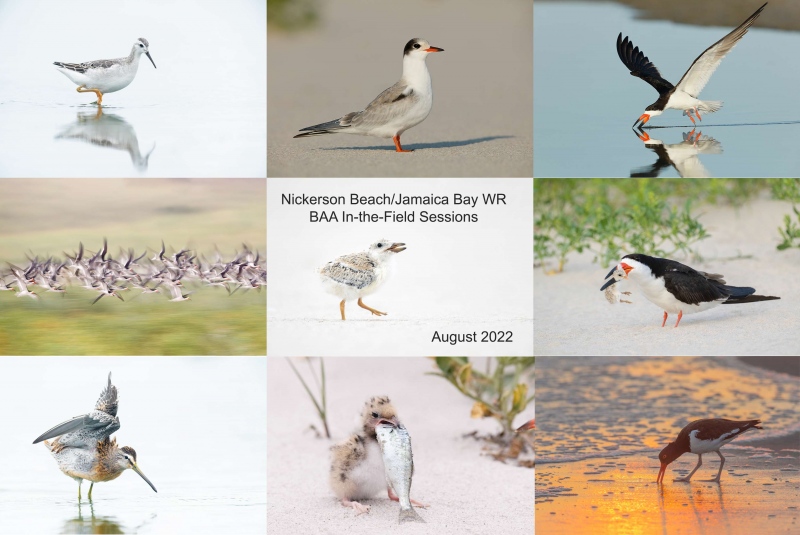

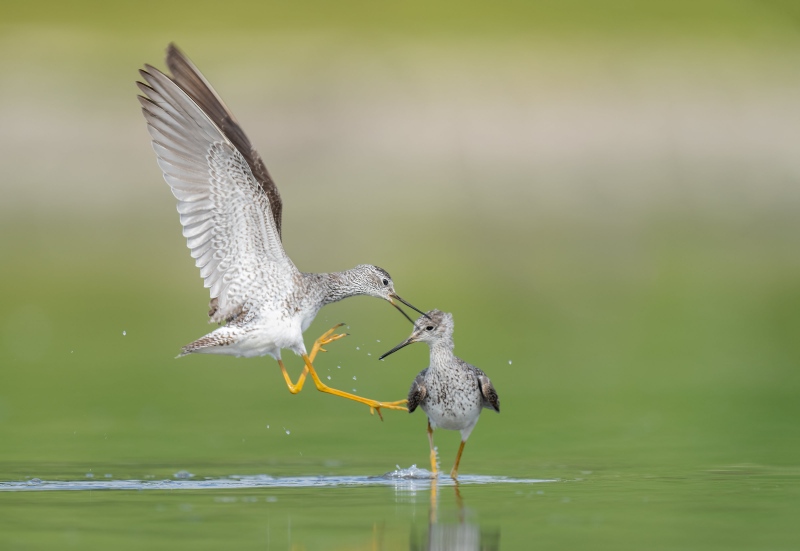
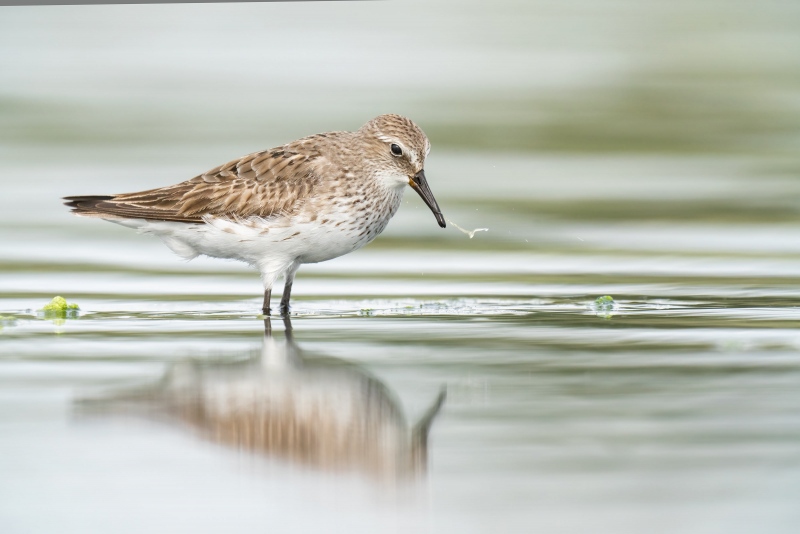
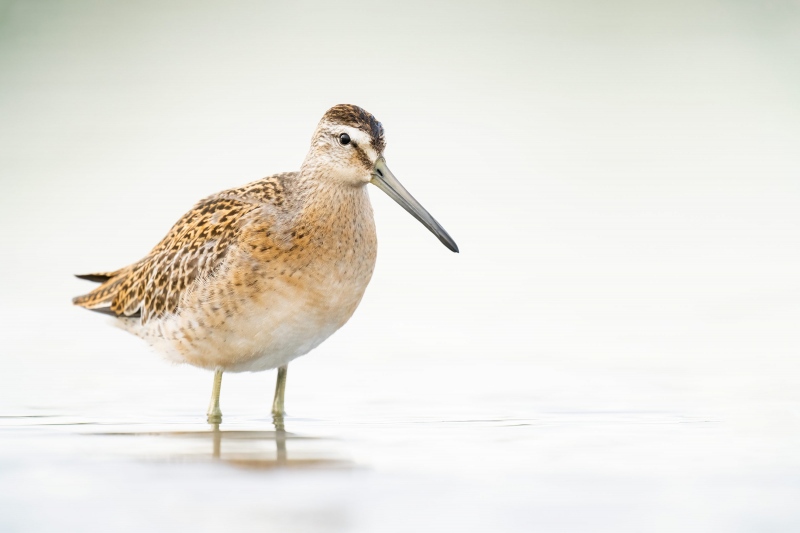
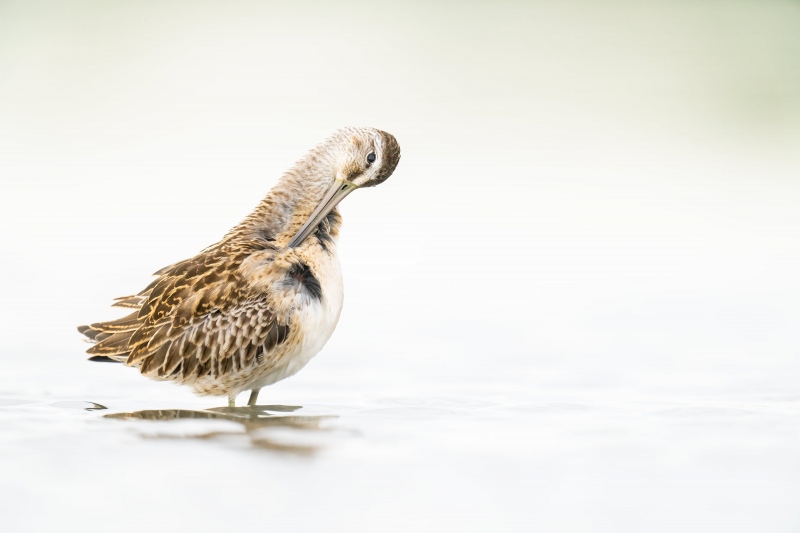













WRT quality, I think when the image conveys story being told, then the story trumps the technical considerations. Perhaps this is more a “thing” in the journalism world, but there can be some overlap: the old mantra from the 4×5 days was “F/8, and be there”.
I like #1 the best, if only from the timing / capture aspects, though I would have a hard time convincing anyone I had waited for the perfect instant to “get the alignment with the eye”. I believe there is a place for good fortune in these efforts. 20 FPS does not hurt, either.
I’d be happy if any of those shots had been mine. Be well out there.
Fortuna favet fortibus.
>> Do you get a pass on unsharpness and poor image quality with images that portray spectacular action? When, and why or why not? <<
I think the answer is unquestionably yes. Motion blur and other image imperfections can create a semse of immediacy and action. See, for example, this image:
http://1.bp.blogspot.com/-Yea6uOhPIPY/UukpcWFTrOI/AAAAAAAAqjo/cPftr7UOwpA/s1600/Robert+Capa+-+D-day-landings,+Omaha+Beach,+Normandy.jpg
Thanks for sharing that image. I have co-written an e-book entitled “A Guide to Pleasing Blurs.” With the yellowlegs images, it is neither pleasingly blurred nor sharp. And it was intended to be sharp. So for me, that brings it down a notch or two.
with love, and thanks for leaving your comment.
artie
I love the action in the first image and the lack of complete sharpness does not bother me. I will take the action over 100% sharpness especially if it means I need to fumble around with my camera settings and miss the photo opportunity. I realize the goal is to create the best image you can in camera but sometimes the once in a lifetime photo presents itself and as you have said in the past just press the shutter and see what you get. I have been surprised many times.
Thanks, James. While I like the image, I am not over the top about it. Without Top Sharpen AI, I would not have presented it here.
with love, artie
Hi Artie, answering your question regarding Image #1 I would say no. I don’t think wonderful action can make the image a keeper if the image quality is not there.
My favorite of the four images is Image #4, as you wrote a perfect preening pose. I also like Image #3.
Thanks as always, Joe.
with love, artie
The fourth image is the strongest “as is” for me; sharp, compositionally strong, great head angle, good color…well done. The first one is the type of image that would leave me wishing for a mulligan; IF it had been sharper, and IF (for me) the bill of the bird in flight hadn’t overlapped with the head of the wading bird, this would have been a stellar image.
Thanks. I agree on sharper, but the bird on our left is biting the head of the bird on our right 🙂
with love, a
Artie, I like all four of those because great site, good light and cute things! #1 and #2 made me Ha/ha/ha because those two photos are funny!
Typos’s: When we first sat down un the mud.
a clear look at the bird’s face and eye eye
Thanks and fixed with love, Paul. Would love it too if you commented on your favorite image when you visit.
artie
#4 wins this one for me. I love preening activity and this one ticks all the boxes. For me it’s the experience of being with the bird while it goes about its important business undeterred. Special moment here with the dowitcher.
I agree that it is a pretty much perfect preening image and I love the high key as well.
thanks with love, a
Agreed, the first one is definitely my favorite despite the issues you mentioned. Motion blur is used very effectively to convey a sense of motion and adds drama to a scene. This was fortuitous in this image.
Thanks, Adam. That one is pretty good but not my fave.
with love, artie
Hi, Artie. I like the first image, of the greater yellowlegs squabbling, the best. Great color and composition. And fascinating in that only one of the birds seems to be squabbling. The other one looks unperturbed, like Alice in the Honeymooners when Ralph is yelling at her “You’re a blabbermouth!”
“To the moon, Alice!”
with love, artie
I agree with David. “One of these days”.